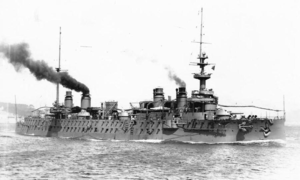Gloire-class cruiser

Gloire in 1913
|
|
| Class overview | |
|---|---|
| Name: | Gloire |
| Operators: |
|
| Preceded by: | Dupleix class |
| Succeeded by: | Léon Gambetta class |
| In commission: | 1904–1933 |
| Completed: | 5 |
| Lost: | 1 |
| Scrapped: | 4 |
| General characteristics | |
| Type: | Armored cruiser |
| Displacement: | 9,534 metric tons (9,383 long tons) |
| Length: | 139.8 m (458 ft 8 in) |
| Beam: | 20.2 m (66 ft 3 in) |
| Draft: | 7.7 m (25 ft) |
| Installed power: |
|
| Propulsion: | 3 Shafts, 3 vertical triple-expansion steam engines |
| Speed: | 21 knots (39 km/h; 24 mph) |
| Range: | 12,000 nautical miles (22,000 km; 14,000 mi) at 10 knots (19 km/h; 12 mph) |
| Complement: | 612 |
| Armament: |
|
| Armor: |
|
The Gloire-class cruisers were a group of five armored cruisers built for the French Navy during the first decade of the 20th century.
The Gloire-class ships were designed as enlarged and improved versions of the Gueydon-class armored cruisers by the naval architect Emile Bertin. Their crew numbered 612 officers and enlisted men. The ships measured 139.8 meters (458 ft 8 in) overall, with a beam of 20.2 meters (66 ft 3 in) and a draft of 7.7 meters (25 ft 3 in) Designed to displace 9,856 metric tons (9,700 long tons), they actually displaced 9,458 to 10,212 metric tons (9,309 to 10,051 long tons).
The ships had three vertical triple-expansion steam engines, each driving one propeller shaft. The engines were rated at a total of 20,500 indicated horsepower (15,300 kW), using steam provided by 24 Belleville water-tube boilers, except for Condé and Gloire, which had 28 Niclausse boilers. They had a designed speed of 21.5 knots (39.8 km/h; 24.7 mph). They carried up to 1,590 long tons (1,620 t) of coal and could steam for 12,000 nautical miles (22,000 km; 14,000 mi) at a speed of 10 knots (19 km/h; 12 mph).
The main armament of the Gloire-class cruisers consisted of two 194 mm (7.6 in) guns mounted in single-gun turrets fore and aft. Their intermediate armament was eight 164 mm (6.5 in) guns. Four of these were in single gun turrets on the sides of the ship and the other four were in casemates. For anti-torpedo boat defense, they carried six 100 mm (3.9 in) guns in casemates and eighteen 47 mm (1.9 in) Hotchkiss guns. They were also armed with five 450-millimeter (17.7 in) torpedo tubes; two of these were submerged and the others were above water.
...
Wikipedia
